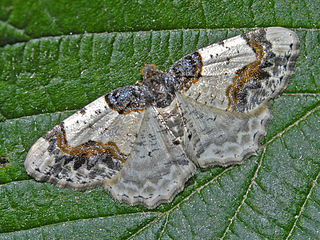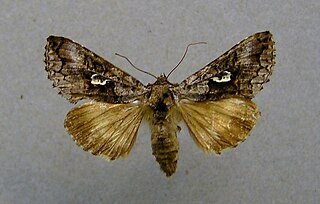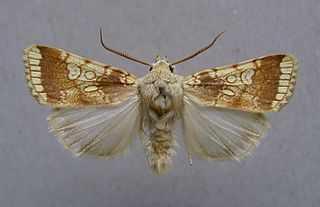
Acronicta rumicis, the knot grass moth, is a species of moth which is part of the genus Acronicta and family Noctuidae. It was first described by Carl Linnaeus in his 1758 10th edition of Systema Naturae. It is found in the Palearctic region. A. rumicis lives and feeds on plants located in wide-open areas. At its larval stage, as a caterpillar, it causes such a large impact as a crop pest that it has received much attention and research. A. rumicis feeds on maize, strawberries and other herbaceous plants.

Ligdia adustata, the scorched carpet, is a moth of the family Geometridae.

Protodeltote pygarga, the marbled white spot, is a species of moth of the family Noctuidae. It is found in the Palearctic realm.

Katha depressa, the buff footman, is a moth of the family Erebidae found in Asia and Europe. It was first described by Eugenius Johann Christoph Esper in 1787.

The pale-lemon sallow is a moth of the family Noctuidae. It is found from Europe to Anatolia and Morocco.

Syngrapha interrogationis, the scarce silver Y, is a moth of the family Noctuidae. It is found in northern part of the world including Alaska, Canada, Iceland, Europe, Siberia, the Pacific Northwest region of the United States, and Northeast Asia.

Epirrhoe galiata, the galium carpet, is a moth of the family Geometridae.

Euphyia biangulata, the cloaked carpet, is a moth of the family Geometridae. It is found in most of Europe and the Middle East.

Cucullia xeranthemi is a species of moth of the family Noctuidae. In southern Europe, it is found locally from northern Spain, Italy and southern France to the Balkans. In the east, it is found from Lower Austria and Hungary to southern Russia and western Siberia.

Lithophane ornitopus, the grey shoulder-knot, is a moth of the family Noctuidae. The species was first described by Johann Siegfried Hufnagel in 1766 and is found in most of the Palearctic realm from Ireland east to Siberia.

Agonopterix purpurea is a moth of the family Depressariidae. It is found in most of Europe.

Agonopterix kaekeritziana is a moth of the family Depressariidae. It is found in most of Europe east to the Near East and the eastern part of the Palearctic realm.

Perittia obscurepunctella is a moth of the family Elachistidae found in Europe.

Depressaria daucella is a moth of the family Depressariidae. It is found in most of Europe, except most of the Balkan Peninsula. It is also found in North America.

Lithophane furcifera, the conformist, is a moth of the family Noctuidae. The species was first described by Johann Siegfried Hufnagel in 1766. It is found from central Europe, east to the Black Sea region, the Caucasus and western Siberia. In the mountains, it is found up to elevations of 1,800 meters.

Ceratophaga vastella, or the horn moth, belongs to the clothes moth family Tineidae and is noted for its larva's ability to feed on keratin from the horns and hooves of dead ungulates, and occasionally on dried fruit or mushrooms. Keratin, a protein which makes up skin, hair, nails and feathers, is extremely resistant to proteolysis by the enzymes from specialised micro-organisms such as fungi and bacteria.

The heart moth is a species of moth of the family Noctuidae. It is found locally in Europe. It is also present in Turkey, Transcaucasia, the Caucasus, Israel, Iran and Iraq.

Helcystogramma convolvuli, the sweet potato moth, sweetpotato webworm moth, sweetpotato leaf roller or black leaf folder, is a moth of the family Gelechiidae. It is mainly found in Asia and Africa, but there are also records from Oceania, the Middle East, the Caribbean and Florida in the United States. The species is also found on the Canary Islands and Madeira.

Mniotype adusta, the dark brocade, is a moth of the family Noctuidae. It was described by Eugenius Johann Christoph Esper in 1790. It is found throughout much of the Palearctic from Europe to Japan, China and Mongolia. It is also found in North America. The habitat consists of heathland, chalky downland, fenland, moorland and upland areas.
Oreoleptidae is a family of flies. The family was established in 2005 on the basis of the type species Oreoleptis torrenticola placed in the monotypic genus Oreoleptis. The only known species was collected from the Rocky Mountains where the larvae grow in torrential streams. Larvae have also been found in groundwater wells. The larvae are similar to those of Athericidae and Tabanidae but with long crocheted false-legs (prolegs) arising from abdominal segments 2-7. The larvae have hollow mandibular hooks.


















